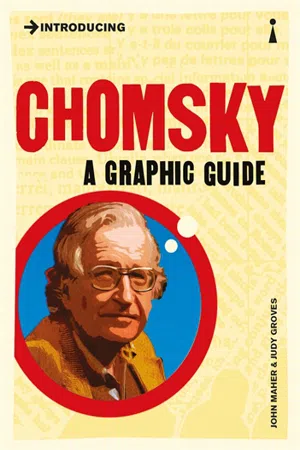
- 176 pages
- English
- ePUB (mobile friendly)
- Available on iOS & Android
About This Book
Can it be that the human brain possesses an in-built faculty for language? Noam Chomsky, one of the most brilliant linguists of the 20th century, believes that it does- that there exists a 'universal grammar' common to all languages. Around the world children learn, in very similar ways, languages that seem entirely different. This is possible, Chomsky argues, because all human languages and their grammatical structures are linked in the human brain.Chomsky is controversial and yet highly influential, both in his pioneering work in linguistics and in his unrelenting critique of international power and his commitment to freedom and justice. These two 'Chomskys' are heirs to the Enlightenment tradition, and this book is the ideal introduction to them both.
Frequently asked questions
Information
Introducing Chomsky

It is. In my view, the human brain has an innate language faculty and part of this biological endowment is a system of principles common to all languages, which is the topic of the theory of “Universal Grammar”.
Being and Language

The task of linguistics is to provide deep account of human language.
The Language Bell

O-YASUMI NASAI

Language Use


THE SOCIOLECTS OR DOCTOR AND SPORTS COMMENTATOR.
How Do We Know Language?

ILLONGO IN THE HEAT OF THE VISAYAN ISLANDS IN THE PHILIPPINES.
THERE ARE SOME 5000 MEMBERS IN THE COMPANY OF LANGUAGES WITHIN THE BORDERS OF LESS THAN 200 NATIONS.
The Diversity Diversion

I WAS VERY PLEASED. IT WAS RAINING HEAVILY BUT I KEPT PLAYING IN THE ALLEY ANYHOW.
Getting to the Core of Language

ONLY WITH THE PROPER “PSYCHIC DISTANCE” DO WE NOTICE THAT THE SIMILARITIES ARE MARKED AND THE DIVERGENCES MARGINAL.
LANGUAGE, LIKE THE MOVEMENT OF THE PLANETS AND GRAVITATIONAL CONSTANTS, IS TAKEN FOR GRANTED, PEOPLE HAVE NO INTUITION ABOUT THE RULES OF CLASSICAL PHYSICS.
How Do We Explain Language?

Analysis of language is not straightforward. It is by no means transparent least of all its definition.
DO WE NOT SHARE LANGU...
Table of contents
- Cover
- Title Page
- Copyright
- Contents
- Introducing Chomsky
- Bibliography
- Acknowledgements
- About the authors
- Index